|
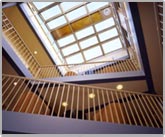
Atrium designed by Locus Architecture, Re/Construction.
Photo: David Wakely
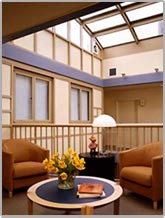
Atrium designed by Tsao Design.
Photo: David Wakely
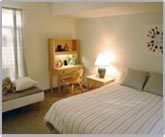
Bedroom designed by ADD Inc.
Photo: David Wakely
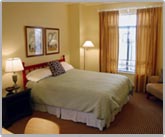
Bedroom designed by Babey Moulton Jue & Booth.
Photo: David Wakely
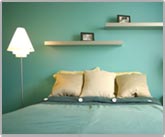
Bedroom designed by Gordon H Chong & Partners.
Photo: David Wakely
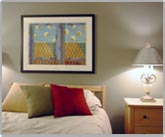
Bedroom designed by IA Interior Architects.
Photo: David Wakely
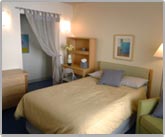
Bedroom designed by SMWM.
Photo: David Wakely
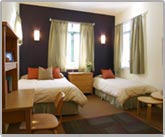
Bedroom designed by Tsao Design.
Photo: David Wakely
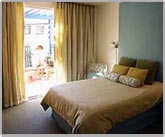
Bedroom designed by Huntsman Architectural Group.
Photo: David Wakely
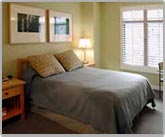
Bedroom design by RMW Architecture & Interiros.
Photo: David Wakely
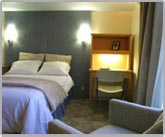
Bedroom designed by SmithGroup.
Photo: David Wakely
|
|
 |
Healing Stories: Renovating San Francisco's Ronald McDonald House
By Kenneth Caldwell
Architects often address their desire to help others through volunteer work. One advantage of volunteering design services is its immediacy. You can see the physical manifestation, but more importantly you can meet the people you are helping. Across the country, Ronald McDonald Houses offer shelter to families of critically ill children who require attention at nearby medical centers. In San Francisco, the Ronald McDonald House has a history of asking architects for help. They answered yes in the 1980s and again in 2001.
When San Francisco's Ronald McDonald House opened in January 1989, the project was well received by its users and went on to receive design awards and press. The original architect, Berkeley's ELS Architecture and Urban Design, had designed the project for a reduced fee. The project architect went on to serve on the board of directors for several years. As everybody will tell you, "It's that kind of project."
The surrounding environment, an eclectic mix of Victorians, drab 1950s-era cracker boxes, and a medical campus, provided a contextual challenge to Donn Logan, FAIA, and his design team. Logan comments, "I was looking for a solution that could mediate all these different styles. Some of Adolf Loos's work seemed an appropriate model because it is so simple, and I was also influenced by Aldo van Eyck's Hubertus House, another building with a similar social mission and beautiful blue metal windows. From these inspirations we fashioned the street elevation, which is linked to a metal atrium that is the essence of the building's interior."
A spacious foyer provides a transition from the street to the comfort of the home away from home. It also provides a convenient parking place for baby strollers. At the center of the house, the three-story atrium brings light into the core and serves as the center of an ingenious circulation system. Residents have to pass through the primary social space to reach the staircase to their rooms. Movement is visible and encourages interaction between residents and staff. Nancy McCluskey-Moore, former development director for the house, agrees. "The heart and soul of staying at a Ronald McDonald House is the sharing and support," she says. "I saw mothers saying things they could not say to their own families. The design encouraged that."
At the base of the atrium on the ground floor, was a living room, a dining room facing the back garden, and an ample kitchen for the residents, who prepare their own meals. Having hosted more than 2,800 families over a dozen years, the house needed renovation. After making observations and listening to feedback, the organization decided to change the use of some spaces. Although the fireplace had been a strong symbol of home, it was not used because the atrium was naturally warm. "The truth is nobody wanted to clean it out," says Ronald McDonald House Executive Director Peggy McGuire, laughing.
Families wanted a larger space for dining and kids needed more room to play.
Project Manager Re/Construction, working with Locus Architecture, designed tiered terraces for lounge seating on the second and third levels. Both firms, working on a reduced fee, felt it was important to unite the three levels into a single dynamic common area.
While there was an abundance of daylight, there were not enough cozy corners to hang out in. McGuire continues, "Imagine a multigenerational family at home, which we often have here. Parents might be in the kitchen, grandparents in the dining room watching the little ones in the playroom, and another member upstairs reading. They can be in separate spaces but they are connected as you are in your home. We are not a hotel, but a home."
When asked about the changes in the house and the flexibility of the design, the original project architect Avery Taylor Moore comments, "The floor plan was originally conceived as a nine-square module, with the central open space guaranteeing that families would cross paths. As room assignments and seating areas evolve, the concept has held that this is a shared house with a strong communal core."
The new lounge areas and some life safety upgrades used up the entire renovation budget.
How were they going to redo the rooms where the families live, often for months at a time? McCluskey-Moore knew that donors want visible evidence of their contribution and a new sprinkler system doesn't quite accomplish that. When visiting the University High School's annual San Francisco Decorator Showcase, she had an inspiration. "I thought we could have a showcase for families in need. What if we gave each room to a different design firm? It would be interesting and not too burdensome. I thought we could get the rooms repainted, spruced up some." After several phone calls, McCluskey-Moore reached Nanci Scoular, then a vice president for a large furniture dealer. According to all involved, something quite remarkable happened. Scoular engineered a transformation.
As Scoular tells it, the process was quite simple. "I called up ten great design firms and everybody said yes!" By then she was between jobs and decided it was the right time to give back. What McCluskey-Moore and Ronald McDonald House didn't know was how well-regarded Scoular is in the design community. McCluskey-Moore comments, "We had not kept our contacts in the design community. Nanci opened the doors and kept opening them."
Scoular called mostly on architectural firms that work on commercial projects to see if they could pitch in and redo a single room. "I just called some of my friends," Scoular says. Alice Southwick, one of the room designers, says, "Nanci chose people very carefully. She picked talented people who would work together."
Despite the professionalism that could be expected from such a group, McCluskey-Moore was a little concerned about competition and cohesion. McCluskey-Moore says, "I thought they might be competitive. The fact we had no budget helped bring cohesion, but it was really the spirit of the project that did it." Although the bedrooms shared a similar program, there was room for individuality. Designer Donald Cremers of SMWM says, "It's rare that doors are left open, so guests don't see into the other rooms. They could be fairly different." He also recalls that when it came time for presentations to Ronald McDonald House, the organization wanted one-on-one presentations to avoid conflict. McCluskey-Moore explains, "I didn't want these people who had given so much time to feel like that they were on review by their peers." But Cremers says, "When the designers caught wind of the one-on-one idea, they all called for all the presentations to be done together."
According to McGuire, the presentation held at SMWM's offices "was an incredible meeting. All of the designers' schemes were different, but they all shared something. Each firm had put themselves in the shoes of a family coming to the house for the first time. Empathy was at the core of their design, that's part of why the collaboration worked."
Scoular says, "We drew straws to see who would get what room; we wanted to make it fair. After we drew straws, we realized that we were short for the public space furnishings. Tsao Design Group stepped up and said they would do those spaces on one condition--they would not give up the bedroom they had been given. IA Interior Archtiects ended up with two rooms. Witnessing this camaraderie and generosity among people who compete every day was one of the rewards of the project." Southwick says, "Over time people began to see themselves as one big project team, not the designer of a single room."
Within the firms, the design process varied. At SmithGroup, Ric Pulley describes it this way: "We kicked off the project with a design charrette in our studio. We provided everyone in the studio with a preliminary program and charged them to do their own thing. Then in an evening with wine and cheese we pinned up all the ideas and had a group discussion on each concept to reach a final design solution." While at Gordon H Chong & Partner's office, Senior Associate and Director of Interiors Cathy Barrett turned most of the reigns over to designer Karie Vagedes. Barrett says, "Karie was two years out of school and asking for larger challenges and I decided to give her a big one." Vagedes remembers, "Design is one thing, design management is quite another. In a way it was like boot camp, but I had a blast. Giving the hours is nothing when you see the people using it. Much of the day-to-day work fell to me, but I got everybody involved. My uncle did the photographs on the walls, my best friend made the bedspread."
The designers entered into the project understanding that there was a set program, some strict parameters, no fee, and indeed, no budget for materials. Designers had to call on their own contacts and resources to find donations. Most of the designers said that the people were happy to give because of the reputation of the house. But there are always glitches in any project, especially an all-volunteer one. Scoular remembers that on the day of the big opening party one of the designers was discouraged because his carpet installer had not shown up. "Alice Southwick got on the phone to Todd Youngs, a manufacturers representative for a carpet company, who was in Seattle that day and he made a call and within minutes an entire team nobody had ever contacted came right over and did the job." Mark Harbick, AIA, design director of Huntsman Architectural Group, remembers the day before opening as a big swap meet. "One firm was offering a mirror for some fabric. Whatever anybody needed somebody would pitch in. I think it reinforced the design community as a community," Harbick says. Jon Kastl of Babey Moulton Jue & Booth went out and bought second-hand furniture and refinished it himself to give his room a custom look. By the end of the project, manufacturers were calling Ronald McDonald House offering office furniture, bathroom cabinets, faucets, even art.
Although each room has a different color scheme, none are jarring and all of them are soothing. As a group, the rooms feel like a contemporary San Franciscan bed and breakfast. During my visits, guests wanted to show off their rooms; they personalize them with photographs and toys, and have a sense of ownership and pride.
Each party was deeply affected and changed by the experience. McCluskey-Moore remembers one resident returning to her room after its makeover bursting into tears. "She said something quickly in Spanish that I could not understand. Somebody told me later that she had told them that it was the nicest place she had ever lived. It was very poignant." But there was a practical effect for the house as well. Since the house had not been renovated since it opened, the volunteer base had not expanded much. McCluskey-Moore remembers, "We had paint crews from a traveling church group, company groups from corporations like the Gap, and individuals who knew how to build things. And many of them continue to volunteer there." McGuire adds, "One of the fathers of a child with a kidney transplant became the all-around handyman.... It gave him something to do."
At the firm level there was also an impact. When asked why his firm took the project on, Pulley says, "Our firm's philosophy is that healthcare interiors should be healing environments. So this project was in alignment with our larger purpose. In the process we had to imagine what it would be like to be a family facing the situations these people are coping with. Then everybody came together, whether it was calling vendors for donations or actually doing the carpentry. As a team we shared a powerful emotional experience. I think people throughout the firm saw how important a beautifully designed space is in terms of getting through illness."
Most of the participants tell moving stories of observing the residents and meeting them and their families. For Jim Archibald of RMW Architecture & Interiors it was healing in a very personal way. Two weeks after the kick-off meeting he was crossing the street and was hit by a car and seriously injured. While he recovered at home he worked via computer and phone from the hospital bed installed in his living room. He says, "Being incapacitated gives you quite a perspective. Rather than dwell on my own misfortune, I had something positive to occupy my time and attention." He acknowledges that staying connected with people was important during his recovery. "I was able to attend the big presentation in a wheelchair and the support I got there was very motivating. As the house renovation progressed I was also progressing and I attended the grand opening on just one crutch." When he finished the project he continued his work by becoming involved with Philanthropy By Design, and now serves on their board of directors.
Scoular says, "I came here from South Africa. I was an outsider and this city and this community has embraced me. Here was a chance to give something back. When I was growing up in South Africa making a real difference meant radical change and the risk of imprisonment. What I learned from the Ronald McDonald House project, is that no matter what the level of change, it is so powerful to reach out and ask your friends to help people in need, to ask your community to join you. In this case, we did it through design. And we made a difference in people's lives. I am reminded that design can be very powerful in many, many ways."
Kenneth Caldwell is a communications consultant and writer based in Oakland, California.
Design Team
Client: Ronald McDonald House�San Francisco
Architect: Locus Architecture
Project Manager: Re/Construction
Room and Public Space Interiors
Volunteer Coordinator: Nanci Scoular
Design Firms:
ADD, Inc.
Babey Moulton Jue & Booth
Gordon H. Chong & Partners
Huntsman Architectural Group
IA Interior Architects
RMW
SmithGroup
SMWM
TSAO Design Group
|